Publications
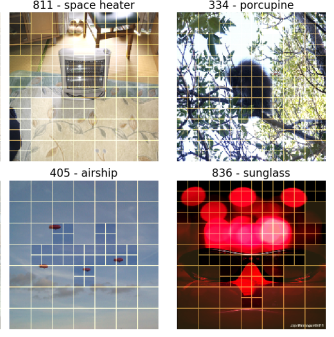 | MSViT: Dynamic Mixed-Scale Tokenization for Vision Transformersin ICCV Workshop on New Ideas in Vision Transformers (NViT), 2023 The input tokens to Vision Transformers carry little semantic meaning as they are defined as regular equal-sized patches of the input image, regardless of its content. However, processing uniform background areas of an image should not necessitate as much compute as dense, cluttered areas. To address this issue, we propose a dynamic mixed-scale tokenization scheme for ViT, MSViT. Our method introduces a conditional gating mechanism that selects the optimal token scale for every image region, such that the number of tokens is dynamically determined per input. In addition, to enhance the conditional behavior of the gate during training, we introduce a novel generalization of the batch-shaping loss. We show that our gating module is able to learn meaningful semantics despite operating locally at the coarse patch-level. The proposed gating module is lightweight, agnostic to the choice of transformer backbone, and trained within a few epochs with little training overhead. Furthermore, in contrast to token pruning, MSViT does not lose information about the input, thus can be readily applied for dense tasks. We validate MSViT on the tasks of classification and segmentation where it leads to improved accuracy-complexity trade-off. @InProceedings{Havtorn_2023_ICCVW, author = {Havtorn, Jakob and Royer, Am\'elie and Blankevoort, Tijmen and Ehteshami Bejnordi, Babak}, title = {MSViT: Dynamic Mixed-Scale Tokenization for Vision Transformers}, booktitle = {ICCV Workshop on New Ideas in Vision Transformers (NViT)}, year = {2023} } |
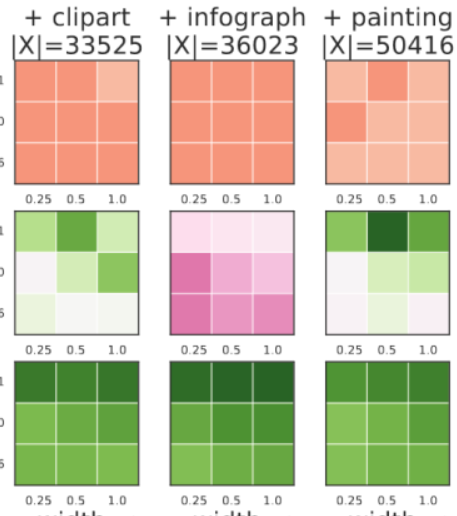 | Scalarization for Multi-Task and Multi-Domain Learning at Scalein Conference on Neural Information Processing Systems (NeurIPS), 2023 Training a single model on multiple input domains and/or output tasks allows for compressing information from multiple sources into a unified backbone hence improves model efficiency. It also enables potential positive knowledge transfer across tasks/domains, leading to improved accuracy and data-efficient training. However, optimizing such networks is a challenge, in particular due to discrepancies between the different tasks or domains: Despite several hypotheses and solutions proposed over the years, recent work has shown that uniform scalarization training, i.e., simply minimizing the average of the task losses, yields on-par performance with more costly SotA optimization methods. This raises the issue of how well we understand the training dynamics of multi-task and multi-domain networks. In this work, we first devise a large-scale unified analysis of multi-domain and multi-task learning to better understand the dynamics of scalarization across varied task/domain combinations and model sizes. Following these insights, we then propose to leverage population-based training to efficiently search for the optimal scalarization weights when dealing with a large number of tasks or domains. @InProceedings{Royer_2023_NEURIPS, author = {Royer, Am\'elie and Blankevoort, Tijmen and Ehteshami Bejnordi, Babak}, title = {Knowledge Distillation: A Good Teacher Is Patient and Consistent}, booktitle = {Conference on Neural Information Processing Systems (NeurIPS)}, year = {2023} } |
 | Knowledge Distillation: A good teacher is patient and consistentin Conference on Computer Vision and Pattern Recognition (CVPR) (oral), 2022 There is a growing discrepancy in computer vision between large-scale models that achieve state-of-the-art performance and models that are affordable in practical applications. In this paper we address this issue and significantly bridge the gap between these two types of models. Throughout our empirical investigation we do not aim to necessarily propose a new method, but strive to identify a robust and effective recipe for making state-of-the-art large scale models affordable in practice. We demonstrate that, when performed correctly, knowledge distillation can be a powerful tool for reducing the size of large models without compromising their performance. In particular, we uncover that there are certain implicit design choices, which may drastically affect the effectiveness of distillation. Our key contribution is the explicit identification of these design choices, which were not previously articulated in the literature. We back up our findings by a comprehensive empirical study, demonstrate compelling results on a wide range of vision datasets and, in particular, obtain a state-of-the-art ResNet-50 model for ImageNet, which achieves 82.8% top-1 accuracy. @InProceedings{Beyer_2022_CVPR, author = {Beyer, Lucas and Zhai, Xiaohua and Royer, Am\'elie and Markeeva, Larisa and Anil, Rohan and Kolesnikov, Alexander}, title = {Knowledge Distillation: A Good Teacher Is Patient and Consistent}, booktitle = {Proceedings of the IEEE/CVF Conference on Computer Vision and Pattern Recognition (CVPR)}, year = {2022} } |
 | Revisiting single-gated Mixtures of Expertsin British Machine Vision Conference (BMVC), 2022 Mixture of Experts (MoE) are rising in popularity as a means to train extremely large-scale models, yet allowing for a reasonable computational cost at inference time. Recent state-of-the-art approaches usually assume a large number of experts, and require training all experts jointly, which often lead to training instabilities such as the router collapsing In contrast, in this work, we propose to revisit the simple single-gate MoE, which allows for more practical training. Key to our work are (i) a base model branch acting both as an early-exit and an ensembling regularization scheme, (ii) a simple and efficient asynchronous training pipeline without router collapse issues, and finally (iii) a per-sample clustering-based initialization. We show experimentally that the proposed model obtains efficiency-to-accuracy trade-offs comparable with other more complex MoE, and outperforms non-mixture baselines. This showcases the merits of even a simple single-gate MoE, and motivates further exploration in this area. @InProceedings{Royer_2022_BMVC, author = {Royer, Am\'elie and Karmanov, Ilia and Skliar, Andrii and Ehteshami Bejnordi, Babak and Blankevoort, Tijmen}, title = {Knowledge Distillation: A Good Teacher Is Patient and Consistent}, booktitle = {British Machine Vision Conference (BMVC)}, year = {2022} } |
 | Localizing Grouped Instances for Efficient Detection in Low-Resource Scenariosin Winter Conference on Applications of Computer Vision (WACV), 2020 State-of-the-art detection systems are generally evaluated on their ability to exhaustively retrieve objects densely distributed in the image, across a wide variety of appearances and semantic categories. Orthogonal to this, many real-life object detection applications, for example in remote sensing, instead require dealing with large images that contain only a few small objects of a single class, scattered heterogeneously across the space. In addition, they are often subject to strict computational constraints, such as limited battery capacity and computing power. To tackle these more practical scenarios, we propose a novel flexible detection scheme that efficiently adapts to variable object sizes and densities: We rely on a sequence of detection stages, each of which has the ability to predict groups of objects as well as individuals. Similar to a detection cascade, this multi-stage architecture spares computational effort by discarding large irrelevant regions of the image early during the detection process. The ability to group objects provides further computational and memory savings, as it allows working with lower image resolutions in early stages, where groups are more easily detected than individuals, as they are more salient. We report experimental results on two aerial image datasets, and show that the proposed method is as accurate yet computationally more efficient than standard single-shot detectors, consistently across three different backbone architectures. @InProceedings{Royer_2020_odgi, author = {Royer, Am\'{e}lie and Lampert, Christoph H.}, title = {Localizing Grouped Instances for Efficient Detection in Low-Resource Scenarios}, booktitle = {Winter Conference on Applications of Computer Vision (WACV)}, year = {2020} } |
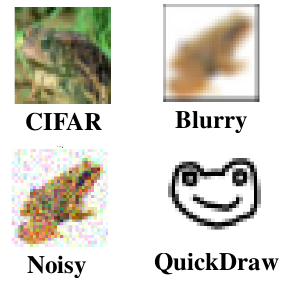 | A Flexible Selection Scheme for Minimum-Effort Transfer Learningin Winter Conference on Applications of Computer Vision (WACV), 2020 Fine-tuning is a popular way of exploiting knowledge contained in a pre-trained convolutional network for a new visual recognition task. However, the orthogonal setting of transferring knowledge from a pretrained network to a vi- sually different yet semantically close source is rarely considered: This commonly happens with real-life data, which is not necessarily as clean as the training source (noise, geometric transformations, different modalities, etc.). To tackle such scenarios, we introduce a new, generalized form of fine-tuning, called flex-tuning, in which any individual unit (e.g. layer) of a network can be tuned, and the most promising one is chosen automatically. In order to make the method appealing for practical use, we propose two lightweight and faster selection procedures that prove to be good approximations in practice. We study these selection criteria empirically across a variety of domain shifts and data scarcity scenarios, and show that fine-tuning individual units, despite its simplicity, yields very good results as an adaptation technique. As it turns out, in contrast to common practice, rather than the last fully-connected unit it is best to tune an intermediate or early one in many domain shift scenarios, which is accurately detected by flex-tuning. @InProceedings{Royer_2020_odgi, author = {Royer, Am\'{e}lie and Lampert, Christoph H.}, title = {A Flexible Selection Scheme for Minimum-Effort Transfer Learning}, booktitle = {Winter Conference on Applications of Computer Vision (WACV)}, year = {2020} } |
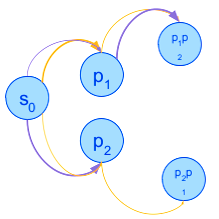 | Multiple-Environment Markov Decision Processes: Efficient Analysis and Applicationsin International Conference on Automated Planning and Scheduling (ICAPS), 2020 Multiple-environment Markov decision processes (MEMDPs) are MDPs equipped with not one, but multiple probabilistic transition functions, which represent the various possible unknown environments. While the previous research on MEMDPs focused on theoretical properties for long-run average payoff, we study them with discounted-sum payoff and focus on their practical advantages and applications. MEMDPs can be viewed as a special case of Partially observable and Mixed observability MDPs: the state of the system is perfectly observable, but not the environment. We show that the specific structure of MEMDPs allows for more efficient algorithmic analysis, in particular for faster belief updates. We demonstrate the applicability of MEMDPs in several domains. In particular, we formalize the sequential decision-making approach to contextual recommendation systems as MEMDPs and substantially improve over the previous MDP approach. @InProceedings{Royer_2015_CVPR, author = {Royer, Am\'{e}lie and Lampert, Christoph H.}, title = {Classifier Adaptation at Prediction Time}, booktitle = {Conference on Computer Vision and Pattern Recognition (CVPR)}, year = {2015} } |
 | XGAN: Unsupervised Image-to-Image Translation for Many-to-Many Mappingsin Domain Adaptation for Visual Understanding Workshop at ICML/IJCAI/EJCAI 2018, 2018 Style transfer usually refers to the task of applying color and texture information from a specific style image to a given content image while preserving the structure of the latter. Here we tackle the more generic problem of semantic style transfer: given two unpaired collections of images, we aim to learn a mapping between the corpus-level style of each collection, while preserving semantic content shared across the two domains. We introduce XGAN (“Cross-GAN”), a dual adversarial autoencoder, which captures a shared representation of the common domain semantic content in an unsupervised way, while jointly learning the domain-to-domain image translations in both directions. We exploit ideas from the domain adaptation literature and define a semantic consistency loss which encourages the model to preserve semantics in the learned embedding space. We report promising qualitative results for the task of face-to-cartoon translation. The cartoon dataset we collected for this purpose, CartoonSet, is publicly availale at https://google.github.io/cartoonset/index.html as a new benchmark for semantic style transfer. @article{DBLP:journals/corr/abs-1711-05139, author = {Am\'{e}lie Royer and Konstantinos Bousmalis and Stephan Gouws and Fred Bertsch and Inbar Mosseri and Forrester Cole and Kevin Murphy}, title = {{XGAN:} Unsupervised Image-to-Image Translation for many-to-many Mappings}, journal = {Domain Adaptation for Visual Understanding Workshop at ICML'18}, year = {2018} } |
 | Probabilistic Image Colorizationin British Machine Vision Conference (BMVC), 2017 We develop a probabilistic technique for colorizing grayscale natural images. In light of the intrinsic uncertainty of this task, the proposed probabilistic framework has numerous desirable properties. In particular, our model is able to produce multiple plausible and vivid colorizations for a given grayscale image and is one of the first colorization models to provide a proper stochastic sampling scheme. Moreover, our training procedure is supported by a rigorous theoretical framework that does not require any ad hoc heuristics and allows for efficient modeling and learning of the joint pixel color distribution. We demonstrate strong quantitative and qualitative experimental results on the CIFAR-10 dataset and the challenging ILSVRC 2012 dataset. @InProceedings{Royer_2017_BMVC, author = {Royer, Am\'{e}lie, Kolesnikov, Alexander and Lampert, Christoph H.}, title = {Probabilistic Image Colorization}, booktitle = {British Machine Vision Conference (BMVC)}, year = {2017} } |
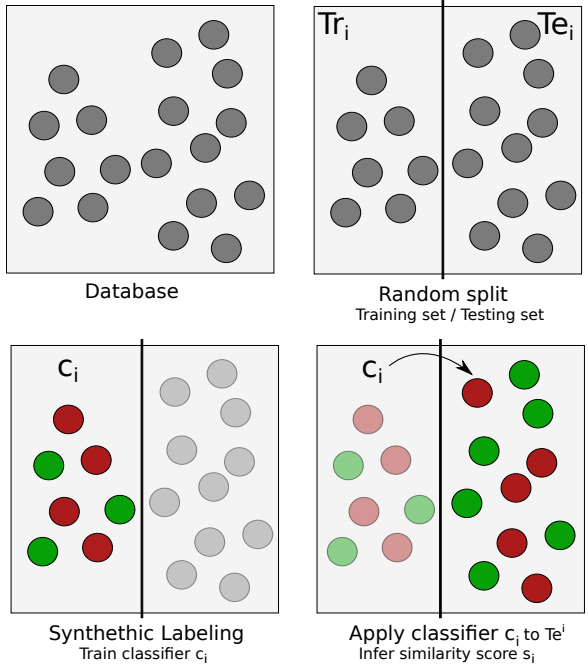 | Audio Word Similarity for Clustering with zero Resources based on iterative HMM Classificationin International Conference on Acoustics, Speech and Signal Processing (ICASSP), 2016 Recent work on zero resource word discovery makes intensive use of audio fragment clustering to find repeating speech patterns. In the absence of acoustic models, the clustering step traditionally relies on dynamic time warping (DTW) to compare two samples and thus suffers from the known limitations of this technique. We propose a new sample comparison method, called ‘similarity by iterative classification’, that exploits the modeling capacities of hidden Markov models (HMM) with no supervision. The core idea relies on the use of HMMs trained on randomly labeled data and exploits the fact that similar samples are more likely to be classified together by a large number of random classifiers than dissimilar ones. The resulting similarity measure is compared to DTW on two tasks, namely nearest neighbor retrieval and clustering, showing that the generalization capabilities of probabilistic machine learning significantly benefit to audio word comparison and overcome many of the limitations of DTW-based comparison. @InProceedings{Royer_2016_ICAPS, author = {Royer, Am\'{e}lie, Gravier, Guillaume and Claveau, Vincent}, title = {Audio word similarity for clustering with zero resources based on iterative HMM classification}, booktitle = {International Conference on Acoustics, Speech and Signal Processing (ICASSP)}, month = {March}, year = {2016} } |
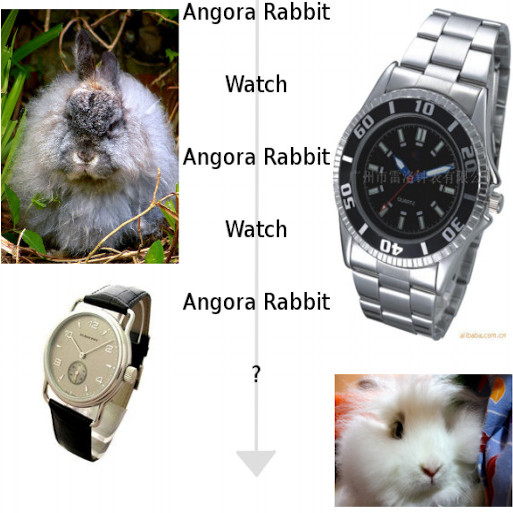 | Classifier Adaptation at Prediction Timein Conference on Computer Vision and Pattern Recognition (CVPR), 2015 Classifiers for object categorization are usually evaluated by their accuracy on a set of i.i.d. test examples. This provides us with an estimate of the expected error when applying the classifiers to a single new image. In real application, however, classifiers are rarely only used for a single image and then discarded. Instead, they are applied sequentially to many images, and these are typically not i.i.d. samples from a fixed data distribution, but they carry dependencies and their class distribution varies over time. In this work, we argue that the phenomenon of correlated data at prediction time is not a nuisance, but a blessing in disguise. We describe a probabilistic method for adapting classifiers at prediction time without having to retraining them. We also introduce a framework for creating realistically distributed image sequences, which offers a way to benchmark classifier adaptation methods, such as the one we propose. Experiments on the ILSVRC2010 and ILSVRC2012 datasets show that adapting object classification systems at prediction time can significantly reduce their error rate, even with additional human feedback. @InProceedings{Royer_2015_CVPR, author = {Royer, Am\'{e}lie and Lampert, Christoph H.}, title = {Classifier Adaptation at Prediction Time}, booktitle = {Conference on Computer Vision and Pattern Recognition (CVPR)}, year = {2015} } |
